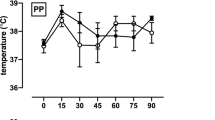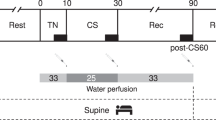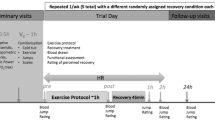Abstract
Purpose
The dysfunctional sympathetic nervous system in individuals with cervical spinal cord injury (CSCI) impairs adrenergic responses and may, therefore, contribute to the blunted post-exercise cytokine response. The purpose of this study was to investigate an alternative way to exercise to induce an acute cytokine response by passive core temperature elevation in CSCI.
Methods
Seven male participants with a motor complete CSCI and 8 male able-bodied controls were immersed for 60 min in water set at a temperature 2 °C above the individuals’ resting oesophageal temperature. Blood was collected pre, post, and every hour up to 4 h post-immersion.
Results
Hot water immersion resulted in an IL-6 plasma concentration mean increase of 133 ± 144 % in both groups (P = 0.001). On a group level, IL-6 plasma concentrations were 68 ± 38 % higher in CSCI (P = 0.06). In both groups, IL-8 increased by 14 ± 11 % (P = 0.02) and IL-1ra by 18 ± 17 % (P = 0.05). Catecholamine plasma concentrations were significantly reduced in CSCI (P < 0.05) and did not increase following immersion.
Conclusions
Passive elevation of core temperature acutely elevates IL-6, IL-8 and IL-1ra in CSCI despite a blunted adrenergic response, which is in contrast to earlier exercise interventions in CSCI. The present study lays the foundation for future studies to explore water immersion as an alternative to exercise to induce an acute cytokine response in CSCI.




Similar content being viewed by others
Abbreviations
- AB:
-
Able-bodied
- ASIA:
-
American spinal injury association impairment scale
- C:
-
Cervical
- CD:
-
Cluster of differentiation
- CSCI:
-
Cervical spinal cord injury
- CV:
-
Coefficient of variation
- IL:
-
Interleukin
- IL-1ra:
-
Interleukin-1 receptor antagonist
- mRNA:
-
Messenger ribonucleic acid
- sICAM:
-
Soluble intercellular adhesion molecule
- TNF:
-
Tumour necrosis factor
References
Banno M, Nakamura T, Furusawa K et al (2012) Wheelchair half-marathon race increases natural killer cell activity in persons with cervical spinal cord injury. Spinal Cord 50:533–537
Bhambhani Y (2002) Physiology of wheelchair racing in athletes with spinal cord injury. Sports Med 32:23–51
Brenner IK, Castellani JW, Gabaree C et al (1999) Immune changes in humans during cold exposure: effects of prior heating and exercise. J Appl Physiol 87:699–710
Cardenas DD, Hoffman JM, Kirshblum S, McKinley W (2004) Etiology and incidence of rehospitalization after traumatic spinal cord injury: a multicenter analysis. Arch Phys Med Rehabil 85:1757–1763
Chen Q, Fisher DT, Clancy KA et al (2006) Fever-range thermal stress promotes lymphocyte trafficking across high endothelial venules via an interleukin 6 trans-signaling mechanism. Nat Immunol 7:1299–1308
Davies AL, Hayes KC, Dekaban GA (2007) Clinical correlates of elevated serum concentrations of cytokines and autoantibodies in patients with spinal cord injury. Arch Phys Med Rehabil 88:1384–1393
DeVivo MJ, Krause JS, Lammertse DP (1999) Recent trends in mortality and causes of death among persons with spinal cord injury. Arch Phys Med Rehabil 80:1411–1419
Dill DB, Costill DL (1974) Calculation of percentage changes in volumes of blood, plasma, and red cells in dehydration. J Appl Physiol 37:247–248
Foster NK, Martyn JB, Rangno RE, Hogg JC, Pardy RL (1986) Leukocytosis of exercise: role of cardiac output and catecholamines. J Appl Physiol 61:2218–2223
Gass EM, Gass GC, Pitetti K (2002) Thermoregulatory responses to exercise and warm water immersion in physically trained men with tetraplegia. Spinal Cord 40:474–480
Gibson AE, Buchholz AC, Martin Ginis KA, SHAPE-SCI Research Group (2008) C-Reactive protein in adults with chronic spinal cord injury: increased chronic inflammation in tetraplegia vs paraplegia. Spinal Cord 46:616–621
Gleeson M, Bishop NC, Stensel DJ, Lindley MR, Mastana SS, Nimmo MA (2011) The anti-inflammatory effects of exercise: mechanisms and implications for the prevention and treatment of disease. Nat Rev Immunol 11:607–615
Kappel M, Stadeager C, Tvede N, Galbo H, Pedersen BK (1991) Effects of in vivo hyperthermia on natural killer cell activity, in vitro proliferative responses and blood mononuclear cell subpopulations. Clin Exp Immunol 84:175–180
Kappel M, Poulsen TD, Hansen MB, Galbo H, Pedersen BK (1998) Somatostatin attenuates the hyperthermia induced increase in neutrophil concentration. Eur J Appl Physiol Occup Physiol 77:149–156
Kesiktas N, Paker N, Erdogan N, Gulsen G, Bicki D, Yilmaz H (2004) The use of hydrotherapy for the management of spasticity. Neurorehabil Neural Repair 18:268–273
Kliesch WF, Cruse JM, Lewis RE, Bishop GR, Brackin B, Lampton JA (1996) Restoration of depressed immune function in spinal cord injury patients receiving rehabilitation therapy. Paraplegia 34:82–90
Kouda K, Furusawa K, Sugiyama H et al (2012) Does 20-min arm crank ergometer exercise increase plasma interleukin-6 in individuals with cervical spinal cord injury? Eur J Appl Physiol 112:597–604
Kruger K, Lechtermann A, Fobker M, Volker K, Mooren FC (2008) Exercise-induced redistribution of T lymphocytes is regulated by adrenergic mechanisms. Brain Behav Immun 22:324–338
Laing SJ, Jackson AR, Walters R et al (2008) Human blood neutrophil responses to prolonged exercise with and without a thermal clamp. J Appl Physiol 104:20–26
Leicht CA, Goosey-Tolfrey VL, Bishop NC (2013) Spinal cord injury: known and possible influences on the immune response to exercise. Exerc Immunol Rev 19:146–165
McCarthy DA, Dale MM (1988) The leucocytosis of exercise. A review and model. Sports Med 6:333–363
Nagao F, Suzui M, Takeda K, Yagita H, Okumura K (2000) Mobilization of NK cells by exercise: downmodulation of adhesion molecules on NK cells by catecholamines. Am J Physiol Regul Integr Comp Physiol 279:R1251–R1256
Paulson TAW, Goosey-Tolfrey VL, Lenton JP, Leicht CA, Bishop NC (2013) Spinal cord injury level and the circulating cytokine response to strenuous exercise. Med Sci Sports Exerc 45:1649–1655
Pedersen BK, Febbraio MA (2008) Muscle as an endocrine organ: focus on muscle-derived interleukin-6. Physiol Rev 88:1379–1406
Rhind SG, Gannon GA, Shek PN et al (1999) Contribution of exertional hyperthermia to sympathoadrenal-mediated lymphocyte subset redistribution. J Appl Physiol 87:1178–1185
Segal JL, Gonzales E, Yousefi S, Jamshidipour L, Brunnemann SR (1997) Circulating levels of IL-2R, ICAM-1, and IL-6 in spinal cord injuries. Arch Phys Med Rehabil 78:44–47
Shephard RJ (2003) Adhesion molecules, catecholamines and leucocyte redistribution during and following exercise. Sports Med 33:261–284
Starkie RL, Rolland J, Febbraio MA (2001) Effect of adrenergic blockade on lymphocyte cytokine production at rest and during exercise. Am J Physiol Cell Physiol 281:C1233–C1240
Steensberg A, Toft AD, Schjerling P, Halkjaer-Kristensen J, Pedersen BK (2001) Plasma interleukin-6 during strenuous exercise: role of epinephrine. Am J Physiol Cell Physiol 281:C1001–C1004
Steensberg A, Fischer CP, Keller C, Moller K, Pedersen BK (2003) IL-6 enhances plasma IL-1ra, IL-10, and cortisol in humans. Am J Physiol Endocrinol Metab 285:E433–E437
Walsh NP, Whitham M (2006) Exercising in environmental extremes: a greater threat to immune function? Sports Med 36:941–976
Welc SS, Clanton TL (2013) The regulation of interleukin-6 implicates skeletal muscle as an integrative stress sensor and endocrine organ. Exp Physiol 98:359–371
Welc SS, Phillips NA, Oca-Cossio J, Wallet SM, Chen DL, Clanton TL (2012) Hyperthermia increases interleukin-6 in mouse skeletal muscle. Am J Physiol Cell Physiol 303:C455–C466
Yamanaka M, Furusawa K, Sugiyama H et al (2010) Impaired immune response to voluntary arm-crank ergometer exercise in patients with cervical spinal cord injury. Spinal Cord 48:734–739
Zeitzer JM, Ayas NT, Shea SA, Brown R, Czeisler CA (2000) Absence of detectable melatonin and preservation of cortisol and thyrotropin rhythms in tetraplegia. J Clin Endocrinol Metab 85:2189–2196
Zhang HG, Mehta K, Cohen P, Guha C (2008) Hyperthermia on immune regulation: a temperature’s story. Cancer Lett 271:191–204
Acknowledgments
We thank all participants for their willingness to take part in this study. Appreciation is extended to the physiotherapy and medical teams in Nachi-Katsuura and Wakayama for their contribution during laboratory testing. This study was supported by grants from the Joint Usage/Research Center of Sports for Persons with Impairments (Tokyo, Japan), and the Research Center of Sports Medicine and Balneology (Natchi-Katsuura, Japan).
Author information
Authors and Affiliations
Corresponding author
Ethics declarations
Conflict of interest
There is no conflict of interest
Ethical standard
All procedures performed in studies involving human participants were in accordance with the ethical standards of the institutional and national research committee and with the 1964 Helsinki declaration and its later amendments.
Additional information
Communicated by Fabio Fischetti.
Rights and permissions
About this article
Cite this article
Leicht, C.A., Kouda, K., Umemoto, Y. et al. Hot water immersion induces an acute cytokine response in cervical spinal cord injury. Eur J Appl Physiol 115, 2243–2252 (2015). https://doi.org/10.1007/s00421-015-3206-9
Received:
Accepted:
Published:
Issue Date:
DOI: https://doi.org/10.1007/s00421-015-3206-9




